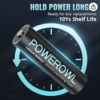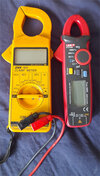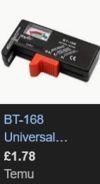An AA cell covers a whole range of cells, some primary some secondary and the problem with the primary cell often very little is given about that the cell can do.
If I look at this one

it says "High Capacity: 16 pack of Powerowl non-rechargeable 3000mAh 1.5V lithium AA batteries with light weight(15g/1pc)and long lifetime(10 years)." I was looking for the discharge chart, I did find a general chart
and I was considering using the lithium primary cell for my cat flap, as it holds the voltage better towards end of life, and removing an alkaline battery I find loads of energy left, and they will work my mouse on the laptop with no problem long after they have failed on the cat flap.
I find there are many items where you can't use secondary cells, as their voltage is slightly lower, it even tells you not to use them on the device instructions, but also the shelf life of a secondary cell can be short, often they will self discharge within 3 months, but not all, so it is rather hard to work out which to use.
My desk has a load of secondary AA cells on it, 700 mAh, to 2500 mAh and this causes a problem with charging, as the early chargers had timers built in, and would stop recharging before the latter cells were fully charged, as to over charging the early cells not sure what happens.
However to test a cell the easy option is use a unit designed for the job
I have used one of these for years, one gets to learn what to expect, although I have used a multi-meter when tester not to hand. With a multi-meter a primary cell is normally better than 1.5 volt when new, although you may still be able to use a battery showing 1.4 volt, I have found often they will not perform under load.
The worse item I have which needs AA batteries is my flash gun, I have bought new batteries and had them fail, or only 4 or 5 flashes from them, some flash guns if you use secondary cells it will damage the flash gun, more expensive flash guns do seem to be OK with secondary cells, and mine I found the better quality secondary cells could give me 100 flashes, so I went over to only using secondary (rechargeable) cells.
I assume it was the high current requirement of the flash gun to re-charge the capacitor that was the problem, and to cause the flash some flash guns the thyristor would short out the battery for a few milliseconds which is why with some flash guns using secondary cells would destroy the unit. Also had to be careful with voltage on the hot shoe, some used around 250 volt on the hot shoe, which could damage new DSLR cameras, mine only used extra low voltage of around 6 volts on the hot shoe, I did measure it.
The TRV heads show the voltage of the pair of AA cells, as does my wall thermostat, but I did have one wall thermostat which would not show the discharged battery icon, but would fail to work, and items designed to use secondary cells like cordless telephones, where swapping the NiCad for NiMh cells caused the newer cells not to fully charge.
Early NiCad chargers used the drop in voltage to sense when charged, at a constant current, the voltage would raise, then just before fully charge it would drop slightly, and the charger would sense this drop, and start a timer, the same does happen with NiMh but not as marked, look at Wikipedia and it shows what is inside some AA batteries
to prevent over and under charge, when you look at that, it is clear shorting out a battery to test it is rather silly, in fact with some it could be dangerous, there are loads of reports about battery fires
and although not a fire, I have had a AAA cell explode when in error recharged, the thing was it was not while being recharged it went bang, but some time latter when my mouse flew into pieces on my desk, it destroyed the mouse.
Most secondary cells at 1.3 volt, but not all, I have had some 1.5 volt secondary cells, the big problem is the writing is so small, I often have to wear two pairs of glasses to see using my mobile phone on macro setting yes can read the writing but this
Is far to small to see with naked eye Warning: Insert correctly (+/-). Do not recharge. Do not throw in fire. Using 4 languages too easy to miss, and most of my rechargeable have a silver label so very easy to get mixed up. And the 1.5V is slightly larger, but still hard to see without two pairs of glasses, so to test batteries by shorting it is far too easy to do it with a secondary cell in error.
And for me my multi-meter does not have a hard wired amp range,

so could not test that way even if I wanted to. And at under £2 for correct tester

why would you want to test with a multi-meter?





